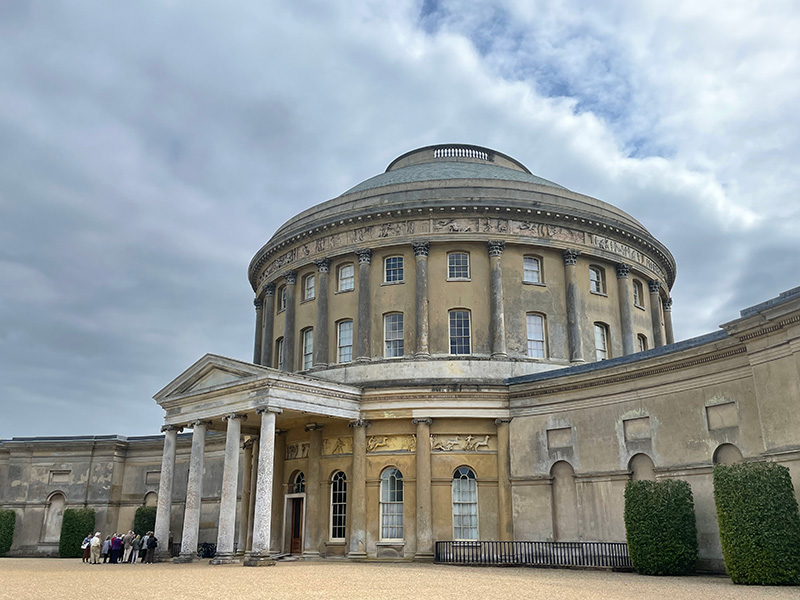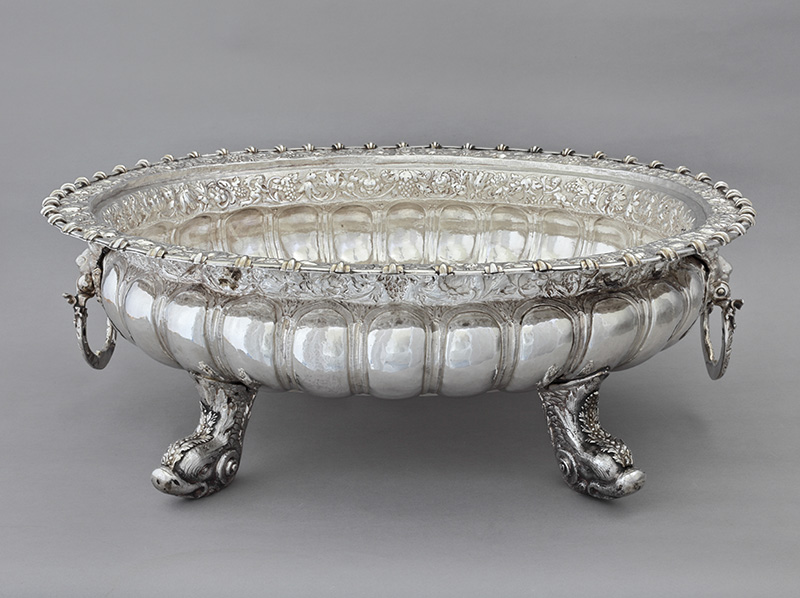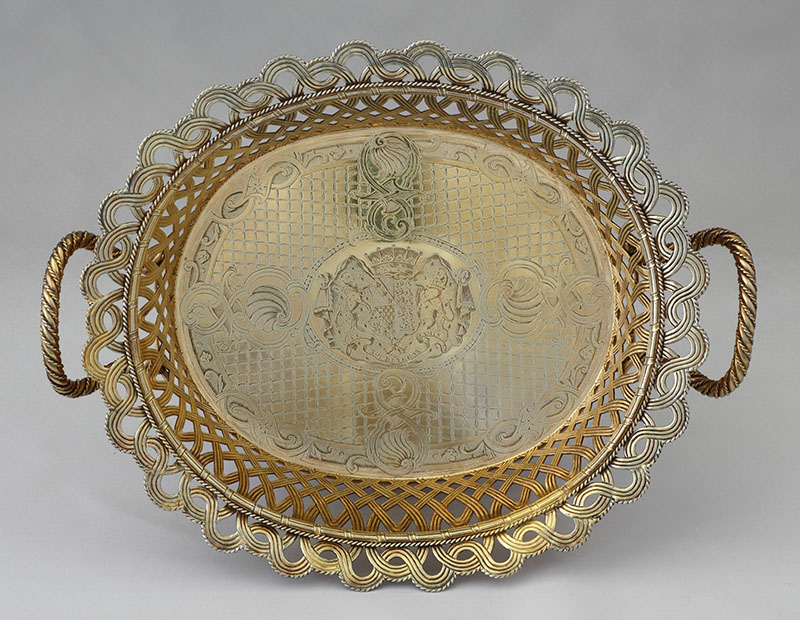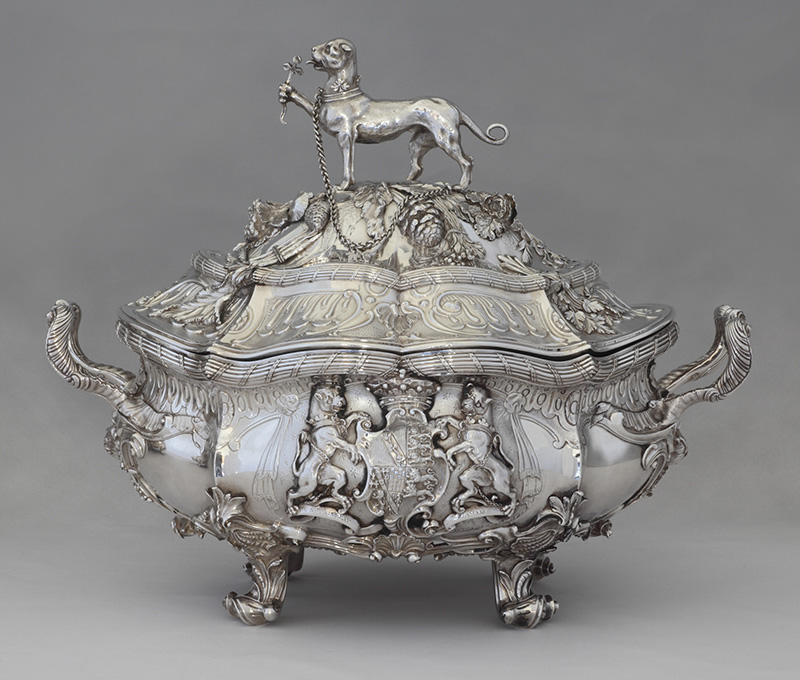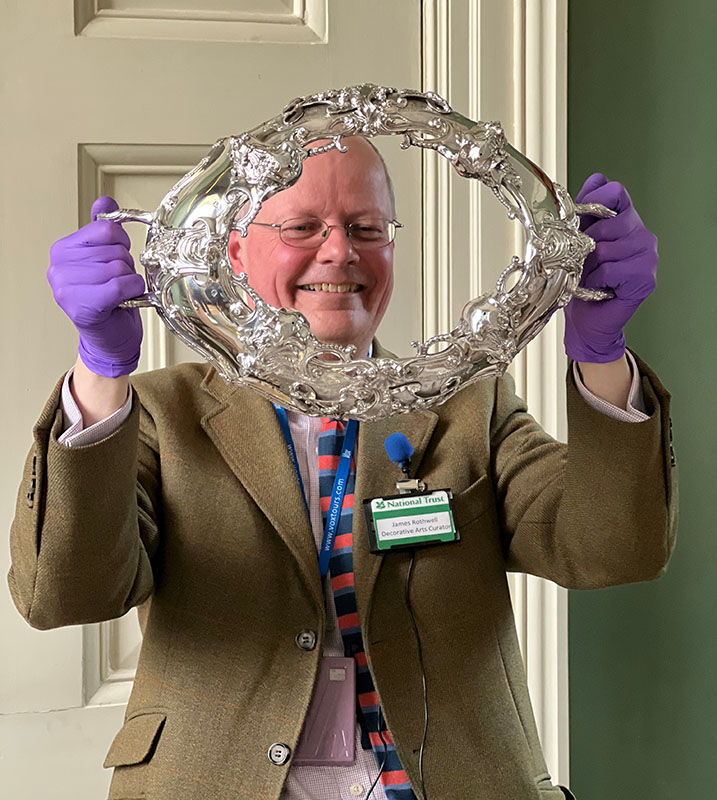Hervey Silver at Ickworth
Click on images to enlarge them and view captions.
by Matthew A. Thurlow
The Decorative Arts Trust’s Spring Study Trip Abroad to East Anglia granted every wish: stunning architecture, noteworthy collections, colorful gardens, bucolic landscapes, and (most surprisingly) abundant sunshine. A talented sequence of colleagues across Norfolk and Suffolk welcomed us, sharing deep insight into the sites and objects we encountered. The privilege of a silver study at Ickworth with James Rothwell, the National Trust’s superstar specialist, was a particular highlight.
Ickworth’s silver holdings are among the most important within the Nationals Trust’s stable of properties. The collection, however, is mostly unrelated to the extravagant and singular country house in which it is housed (figure 1). Commissioned by Frederick Augustus Hervey, 4th Earl of Bristol and Bishop of Derry, the ambitious dwelling was designed by Italian architect Mario Asprucci the Younger and executed by Francis Sandys. The house remained in process at the time of the Earl-Bishop’s death in 1803 and was not completed until 1829 under the auspices of his son, Frederick William Hervey, the 1st Marquess of Bristol.
The importance of the silver collection at Ickworth is primarily tied to the Herveys’ late-17th- and 18th-century forebears, the 1st and 2nd Earls of Bristol. Numbering over one thousand pieces and representing London’s top makers, the assemblage descended through the Hervey family to the 4th Marquess of Bristol, from whose estate the house, contents, park, and gardens passed to the National Trust in lieu of death duties in 1956. The scale and significance of the Hervey silver compelled Rothwell to publish Silver for Entertaining: The Ickworth Collection in 2016, and he brought to bear the considerable research prepared for that comprehensive study through the objects selected for our workshop.
A substantial bottle cistern by London silversmith Robert Cooper (figure 2) illustrates an important subset of the buying habits of John Hervey, later 1st Earl of Bristol. The cistern was initially purchased in 1680–81 by Baptist May, who was an important confidant of Charles II and Hervey’s uncle. Shortly after May’s death in 1697, Hervey acquired a significant amount of silver from the estate, including the cistern. Second-hand silver was sold based on the weight of the object, and Rothwell emphasized how Hervey avoided the additional cost of commissioning new work, perhaps saving upwards of 20 percent of the original price. Given May’s prominence in the late-17th-century silver trade, Hervey’s purchase represented a major boon, even if the cistern was nearly 20 years old at the time of the purchase. The elaborately chased neck was intended to be seen on the inside, suggesting to Rothwell that the cistern was intended for display on the floor and, thus, viewed from above. The 2nd Earl added an engraved crest to the bottom of the vessel in the 1750s, to reinforce his position within the aristocracy.
Later in life, the 1st Earl acquired a bread basket from Paul de Lamerie in 1731–32 (figure 3) that reflects the maker’s mastery of late Regence design and closely resembles an example by de Lamerie bearing the arms of Sir Robert Walpole. The form experienced newfound popularity in the early 1730s, and Hervey may have encountered Walpole’s basket first hand as a fellow intimate of the Hanoverian court. Executed by de Lamerie in white silver, Rothwell surmises that the basket received a new gilt surface once inherited by the 2nd Earl. The basket was sent to Frederick Kandler, who supplied another to match in 1752 and then a further pair in 1768, at which time the entire group of four received the new gilt finish. With their more precious appearance, the baskets were repurposed for the dessert course.
As Rothwell explained through these first two case studies, upon inheriting his grandfather’s silver, the 2nd Earl undertook an intentional and comprehensive course of action to improve upon the out-of-date service. With Kandler’s help, the 2nd Earl added heraldry, commissioned copies, and purchased prominent additions. Rothwell presented a pair of impressive Rococo tureens supplied by Kandler in 1752–53 that reflect this third impulse (figure 4).
The tureen form debuted in England in the early 18th century. Frederick Kandler’s father, Christopher, produced extravagant Baroque examples in the 1720s and 30s, which serve as antecedents of the pair found today at Ickworth. The 2nd Earl’s purchases, however, represent Frederick’s full-blown interpretation of the French Rococo. Acquired at the outset of Hervey’s political career, Rothwell reads a desire to build out a table display suitable for dinners of increasing significance.
No expense was spared for Kandler’s ornamentation of the tureens with cast and chased decoration throughout. As Rothwell kindly demonstrated, however, the bottom of both bases was removed (figure 5), which reduced the amount of material needed and, thus, the weight and cost of the finished product.
The 2nd Earl’s passion for plate was stoked by his service as a prominent Whig politician and diplomat in the 1750s and 60s. Once the 1st Marquess and his family finally arrived at Ickworth in 1829, generations of impressive Hervey silver were displayed in what can only be described as an extraordinary setting. We are grateful for James Rothwell’s efforts to bring this collection to life during our visit.
Matthew A. Thurlow is the Executive Director of the Decorative Arts Trust.
A print version of this article was published in The Magazine of the Decorative Arts Trust, one of our most popular member benefits. Join today!

